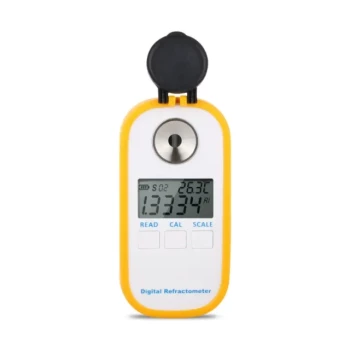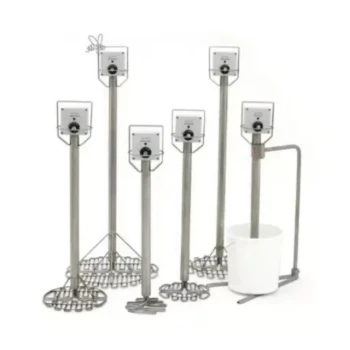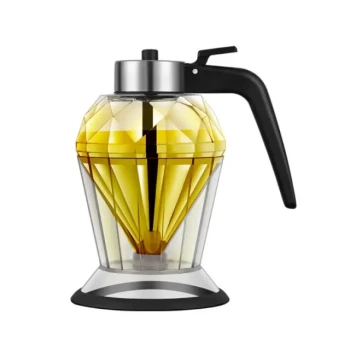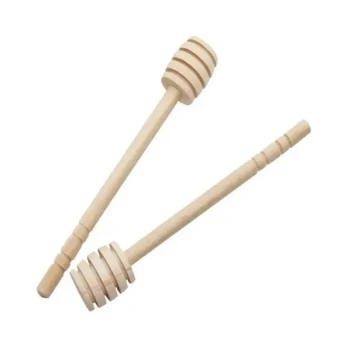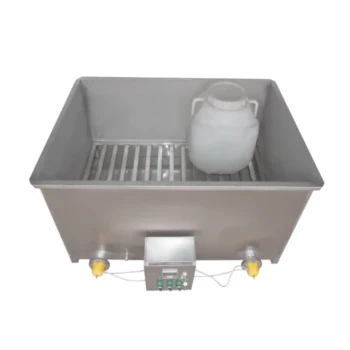For a commercial beekeeper, a honey refractometer is not a luxury; it is an essential instrument for quality control and risk management. This tool provides a precise measurement of the moisture content in honey, which is the single most critical factor in determining its stability, grade, and market value. Without it, a beekeeper risks an entire harvest fermenting in the jar, leading to significant financial loss and damage to their reputation.
A honey refractometer transforms honey harvesting from an art of guesswork into a science of certainty. It provides the objective data needed to guarantee a stable, high-quality product that meets industry standards, thereby protecting the producer's investment and brand.
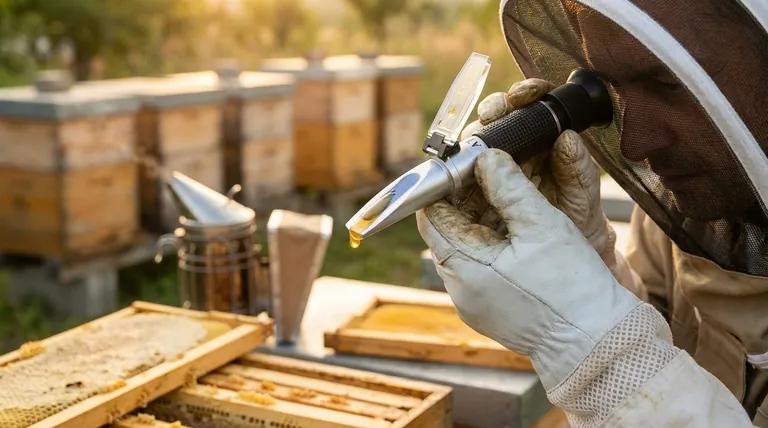
The Science of Honey Stability: Moisture is Everything
For honey to be shelf-stable, its water content must be low enough to prevent fermentation. A refractometer is the only reliable tool for verifying this critical metric.
Why Moisture Content Dictates Quality
Honey naturally contains dormant osmophilic yeasts. If the water content rises above a certain threshold—generally accepted as 18.6%—these yeasts can become active and begin to ferment the sugars in the honey. This process creates alcohol and carbon dioxide, turning the honey fizzy, sour, and unsellable.
The Risk of High Moisture: Spoilage and Financial Loss
Honey with a moisture level above 20% is almost certain to ferment. For a commercial operation, this is a catastrophic failure. It means product recalls, lost revenue, and a tarnished reputation with buyers and consumers. A refractometer provides the crucial data needed to prevent this before the honey is ever extracted and bottled.
The Effect of Low Moisture: Crystallization
Conversely, honey with very low moisture content (e.g., below 17%) is more prone to crystallization. While this can be a textural issue for consumers, it is not a sign of spoilage. The honey remains perfectly safe to eat. Knowing the moisture level allows a producer to anticipate this and manage customer expectations accordingly.
From Guesswork to Data-Driven Decisions
Traditional methods for assessing honey readiness are unreliable. The refractometer provides an objective, scientific measurement that stands up to scrutiny.
Why Visual Cues Aren't Enough
Beekeepers have long used the "shake test" or waited for bees to "cap" 80-90% of the honeycomb cells with wax as a sign that honey is ready. However, these are just indicators. A strong nectar flow or a lack of wax can cause bees to leave honey with high moisture content uncapped. A refractometer removes all doubt.
Providing Objective, Defensible Quality Metrics
When selling to wholesalers or retailers, a commercial beekeeper must be able to guarantee their product's quality. A moisture reading from a calibrated refractometer is a defensible, universally understood metric of honey stability. It proves the product meets USDA Grade A standards, which require moisture content of 18.6% or less.
Optimizing Harvest Timing and Yield
By testing samples directly from the hive, a beekeeper can determine the precise moment a super of honey is ready for harvest. This allows them to confidently pull frames that may not be fully capped, maximizing their yield without compromising the quality of the final product.
Understanding the Practical Application
While essential, it's important to know which type of refractometer to use and how it fits into your workflow.
Analog vs. Digital Models
Most beekeepers use portable refractometers. Analog models are affordable and work by placing a drop of honey on a prism and looking through an eyepiece toward a light source to read a scale. Digital models are more expensive but offer a faster, more precise, and less subjective reading on a digital display. Both are effective when properly calibrated.
The Importance of Calibration
A refractometer is only as good as its calibration. Before use, the device must be calibrated, typically with distilled water or a special calibration oil, to ensure its readings are accurate. Checking calibration regularly is a critical step in professional quality control.
Limitations of the Tool
A refractometer measures one thing: moisture content. It does not measure other important quality factors like color, flavor, floral source, or the presence of contaminants. It is a specialized tool for a specific, but vital, task.
Making the Right Choice for Your Operation
Integrating a refractometer into your process is a strategic decision that depends on your specific goals.
- If your primary focus is commercial sales: A digital refractometer is a non-negotiable investment for ensuring every batch meets legal and commercial quality standards.
- If your primary focus is maximizing harvest efficiency: A refractometer allows you to confidently pull partially capped frames, increasing your overall yield per hive.
- If your primary focus is hobbyist or small-scale production: An analog refractometer is a cost-effective way to elevate your craft and guarantee your honey will store perfectly for years.
Ultimately, using a refractometer is about taking professional control over the quality and stability of your final product.
Summary Table:
| Critical Function | Key Benefit for Commercial Beekeepers |
|---|---|
| Precise Moisture Measurement | Prevents fermentation by ensuring moisture is below 18.6%. |
| Quality Control & Grading | Guarantees honey meets USDA Grade A and buyer standards. |
| Risk Management | Protects against catastrophic financial loss from spoiled batches. |
| Harvest Optimization | Allows confident harvesting of partially capped frames to maximize yield. |
Protect Your Harvest and Your Reputation with Professional-Grade Equipment from HONESTBEE.
As a commercial apiary or beekeeping equipment distributor, you cannot afford the risk of fermentation and product recalls. A reliable honey refractometer is your first line of defense. HONESTBEE supplies the precise, durable tools you need for rigorous quality control, helping you deliver a stable, high-value product that builds trust with buyers.
Ready to upgrade your quality assurance process? Contact our wholesale experts today to find the right refractometer and equipment for your operation's scale and needs.
Visual Guide
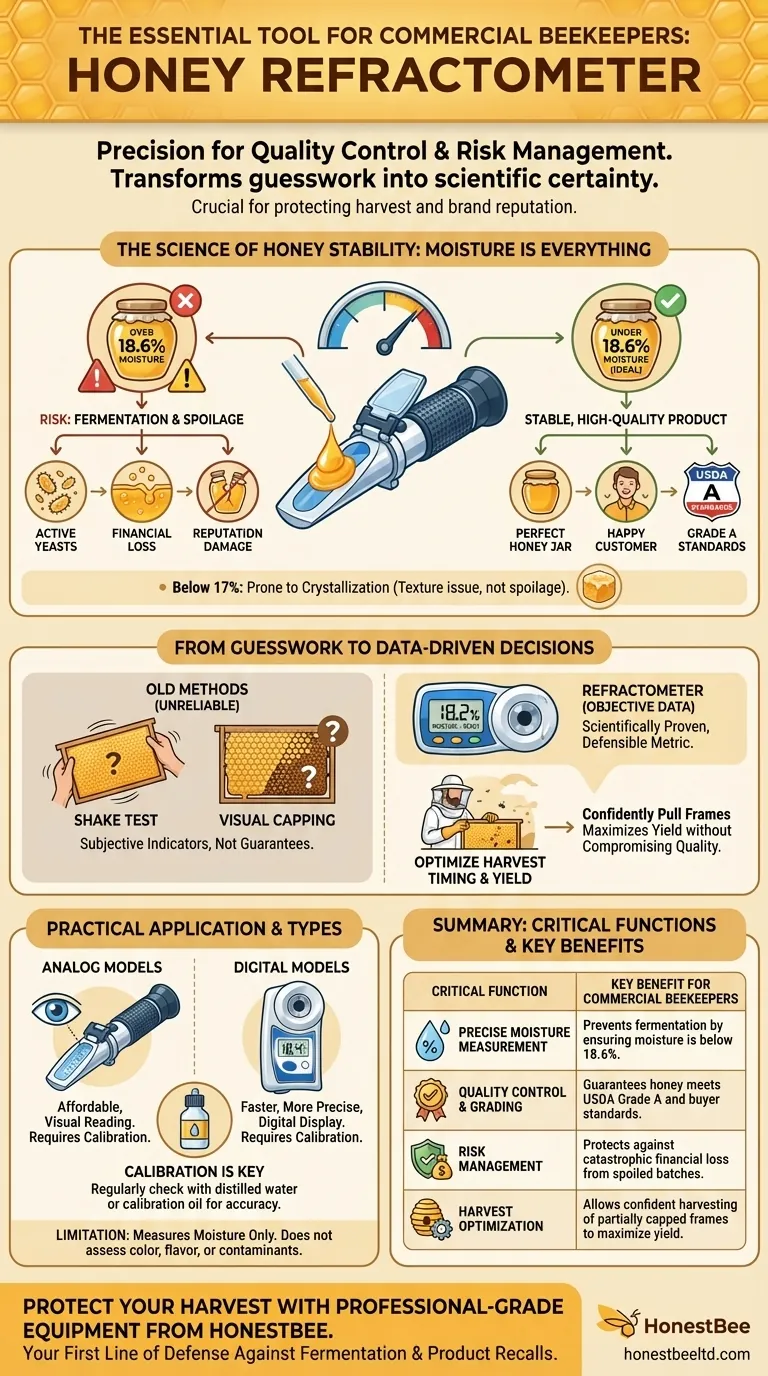
Related Products
- Precision Honey Refractometer Instrument for Quality Assessment
- Digital Honey Refractometer for Precision Measurement of Optimal Honey Quality
- HONESTBEE 72 Frame Industrial Electric Honey Extractor for Beekeeping
- 8-Frame Electric Self-Reversing Honey Extractor Spinner for Commercial Honey Extraction Equipment
- 24 Frame Honey Extractor Commercial Radial Honey Frame Extraction Machine
People Also Ask
- How does a honey refractometer work? Ensure Honey Quality & Harvest Readiness
- What are the key steps to using a honey refractometer? Ensure Honey Quality & Prevent Fermentation
- What are the benefits of using a Pocket Digital Honey Refractometer? Achieve Precision & Speed in Honey Quality Control
- Why is a honey refractometer essential for honey harvesting? Protect Your Harvest from Spoilage
- What are the key points for proper usage of a honey refractometer? Ensure Accurate Moisture Readings Every Time

